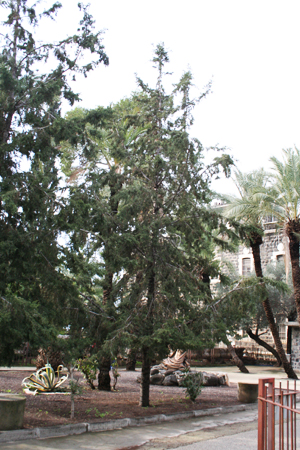
GreenSight returns as ALVIN JOHNSON, in an excerpt from his ebook, Biblical Flora, looks at what the Bible says about the tree known as the te’ashur, likely to be a member of the cypress family…
The te’ashur is likely to be a member of the cypress family. In fact the word te’ashur in modern Hebrew refers to the cypress.
There are various kinds of cypress, some are evergreen, while others are deciduous. The te’ashur might refer to a specific species, that of the Mediterranean cypress (also called the Italian cypress) Cupressus sempervirens.
This is a medium-sized evergreen tree which grows to about 35 metres in height. It is a tree which can live a very long time, some have been reported as being over 1,000 years old.

A cypress in Capernaum, Israel. PICTURE: Alvin Johnson.
“The te’ashur is only mentioned twice in the Old Testament. Both passages are found in Isaiah where the tree is used as an example of future blessing.”
Nogah Hareuveni, founder and director of Neot Kedumim, the Biblical Landscape Reserve in Israel, says with regard to identifying the te’ashur as the cypress, that “some suggest this identification because the cypress tree grows straight up – (yashar in Hebrew) – without branching out, hence the name te’ashur.”
(Some have argued that the Tirzah is also the cypress for similar linguistic reasons. The word Tirzah is derived from the Hebrew word razah, which means ‘lean’. So the tree in question is thought to be slender. )
The cypress tree is well-adapted to the dry climate of Israel, it has cones that can remain viable for up to 20 years. This helps the tree survive in regions which are prone to forest fires. Its wood has been used in the making of coffins from ancient times.
The te’ashur is only mentioned twice in the Old Testament. Both passages are found in Isaiah where the tree is used as an example of future blessing.
Isaiah 41:19 says “I will put in the desert the cedar (erez) and the acacia (shittah), the myrtle (hadas) and the olive (ets shemen). I will set pines (berosh) in the wasteland, the fir (tidhar) and the te’ashur (cypress) together.”
Isaiah 60:13 refers to the te’ashur as an example of the ‘glory of Lebanon’, indicating that it grew there.
‘The glory of Lebanon will come to you, the pine (berosh), the fir (tidhar) and the te’ashur (cypress) together, to adorn the place of my sanctuary; and I will glorify the place of my feet.’
The word tirzah, meanwhile, only appears once in the Old Testament where it is translated as the ‘cypress’, both in the NIV and in the KJV.
Isaiah 44:14 mentions tirzah wood being used to make an idol: “He cut down cedars, or perhaps took a cypress (tirzah) or oak. He let it grow among the trees of the forest, or planted a pine, and the rain made it grow.”





